- Home
- Malaysian Mosques
- Masjid Jamek
Masjid Jamek
Kuala Lumpur
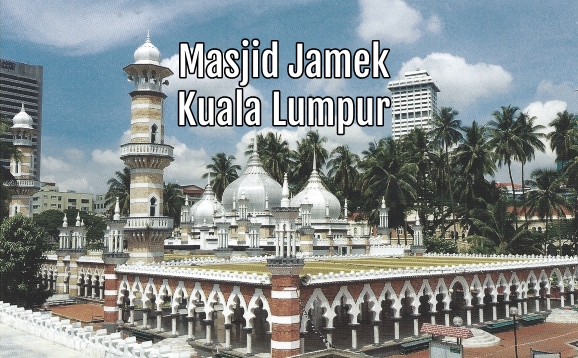
Masjid Jamek is one of the most famous mosques in Kuala Lumpur, Malaysia.
Here are some facts and history:
- It has a distinctive and attractive appearance and was designed in 1908 by A.B.Hubback in his role as Public Works Department Assistant Architect.
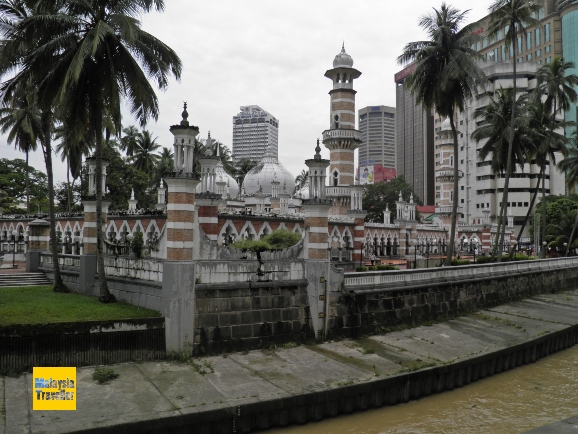
- The mosque is situated where KL's history began, on a raised embankment at the confluence of the Klang and Gombak rivers, the muddy estuaries which gave Kuala Lumpur its name. Both of these rivers have been prone to frequent flooding but the mosque has mostly managed to stay above the flood waters.
- Until the National Mosque opened in 1965 Masjid Jamek was considered as Kuala Lumpur’s primary mosque.
- Prior to construction of the mosque the site was used as KL's first muslim cemetery. Many of the graves were exhumed at the time of construction while others remained within the grave compound. Some old headstones can still be found amid the gardens.
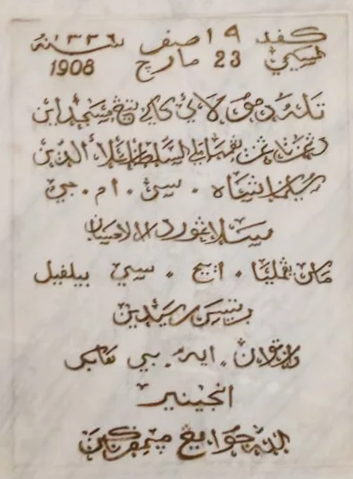
- This foundation stone made of white Ipoh marble and inscribed in Jawi script was laid on the fourteenth day of Safar 1336 (equating to 23 March 1908) by the Sultan of Selangor Sultan Alaeddin Sulaiman Shah in the presence of Mr. H C Belfield, British Resident of Selangor and Mr A.B.Hubback. Nine new coins (three sovereigns and six dollars) were deposited underneath it.
- The mosque was officially opened on 23 December 1909.
- The construction contract was awarded to Towkay Ang Seng (the same contractor who built the nearby Sultan Abdul Samad building) at a budget of $33,538.25 Straits Dollars paid for by the F.M.S. Government, the Sultan and Malay Members of the State Council.
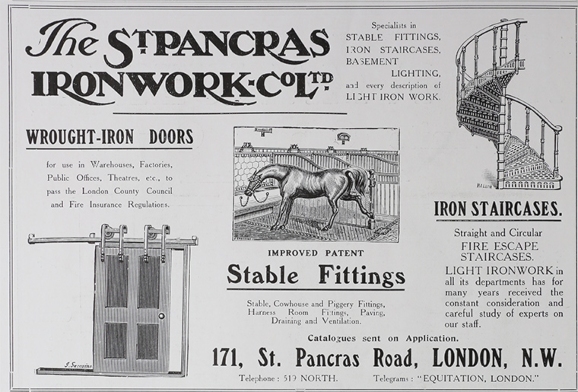
- The cast iron spiral staircases inside the minarets were made in England by St. Pancras Ironworks Co.
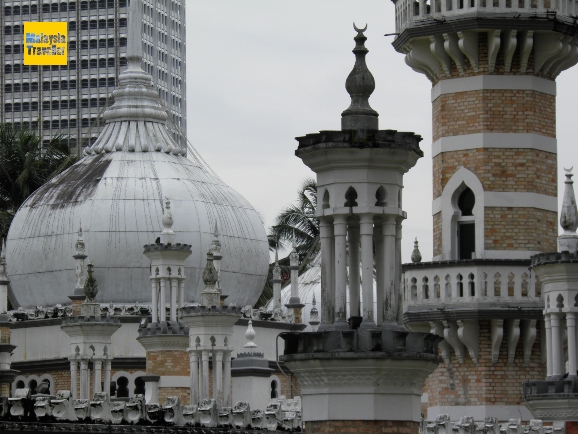
- The architectural style of the mosque has been described as Arabesque and Mughal Eclectic and consists of three onion-shaped domes with Chhatri pavilions and a pair of elegant 27m high minarets. Originally there was a wide courtyard in front but this has since been covered to accommodate more worshippers in comfort.
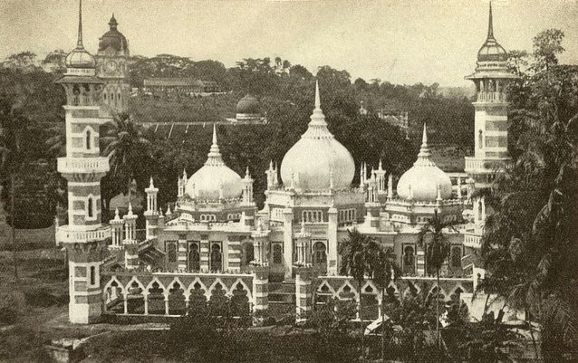
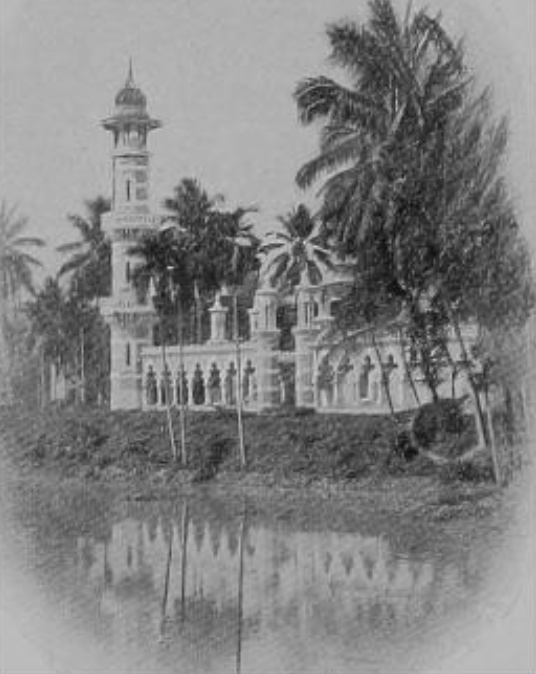
- The mosque was made from brick and plaster with cast concrete minarets and Chhatri's. The domes were made of timber covered with a bitumen and felt material and painted white.
- The floor was originally paved with Doulton tiles in the pattern of a Malay prayer mat but these have since been replaced by white marble.
- Masjid Jamek suffered considerable damage during a Japanese air-raid on 26 September 1941 which killed 3 worshippers.
- The building has been refurbished and altered on a number of occasions over the years. The mosque's compound has always contained a number of coconut palms which help to retain a rural atmosphere in the heart of busy KL. Recently the mosque and its surroundings were given a major facelift as part of the KL River of Life project. Hard landscaping, seating, new planting, fountains and coloured LED lighting were added to enhance the attractiveness of this important KL landmark. A set of old steps leading down to the river was unearthed in 2014 as part of the river clean up and these have been refurbished and incorporated into the remodelled mosque compound.
- In 2017 the mosque was officially renamed the Sultan Abdul Samad Jamek Mosque in honour of Sultan Abdul Samad, the fourth Sultan of Selangor, who reigned from 1857 to 1898.
Visiting Masjid Jamek
Tourists are welcome to visit the inside of the mosque and wander in its surrounding gardens outside prayer times. Helpful staff are often on hand to provide information on the mosque and on Islam if required.
Dress Code
Visitors should proceed to the mosque’s visitor information desk. Non-Muslim women may be provided with a robe and scarf to wear during their visit to the mosque. Men should wear long trousers. Non-Muslim men in shorts may also be given a robe to wear.
Shoes may not be worn and have to be left in the racks provided or on the floor outside the entrance.
Operating Hours
- 10am to 12.30pm
- 2.30pm to 4 pm
Visitors may not enter the mosque during prayer times
Closed for non-Muslim visitors on Fridays.
Entrance is free.
How to Get to Masjid Jamek
The location is marked on this map:
Address:
Masjid Jamek, Jalan Tun Perak, City Centre, 50050 Kuala Lumpur, Wilayah Persekutuan Kuala Lumpur, Malaysia
GPS Co-ordinates:
3°08'56.1"N 101°41'44.3"E
3.148924, 101.695628
Public Transport:
LRT Masjid Jamek Station
Nearby
You can cover all these places and more by followlng my self-guided KL Heritage Trail.
- Home
- Malaysian Mosques
- Masjid Jamek
Share this page:

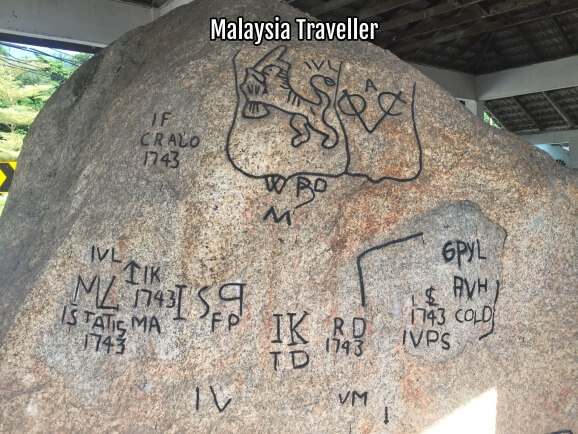


Comments
Have your say about what you just read! Leave me a comment in the box below.